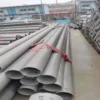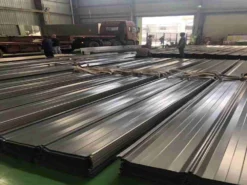Stainless steel plates refer to steel plates that are resistant to corrosion by weak media such as atmosphere, steam and water, while acid-resistant steel plates refer to steel plates that are resistant to corrosion by chemically corrosive media such as acids, alkali and salts.
Chemical Composition:
-304 stainless steel grade: 0Cr18Ni9 (0Cr19Ni9) 06Cr19Ni9 S30408
Chemical composition: C: ≤0.08, Si: ≤1.0 Mn: ≤2.0, Cr: 18.0~20.0, Ni: 8.0~10.5, S: ≤0.03, P: ≤0.035 N≤0.1.
with 304L
304L is more corrosion-resistant, and 304L contains less carbon.
304 is widely used, with good corrosion resistance, heat resistance, low temperature strength and mechanical properties; good hot workability such as stamping and bending, and no heat treatment hardening phenomenon (non-magnetic, service temperature -196°C~800°C).
304L has excellent resistance to grain boundary corrosion after welding or stress relief; it can also maintain good corrosion resistance without heat treatment, and the service temperature is -196°C-800°C.
-316L: (AISI 316L/ SUS316L/S31603/022Cr17Ni12Mo2/022Cr17Ni14Mo2)
C :≤0.030, Si: ≤1.00, Mn:≤2.00, S : ≤0.030, P : ≤0.045, Cr:16.00~18.00, Ni:10.00~14.00, Mo:2.00~3.00
Mechanical Properties:
Tensile strength σb (MPa): ≥480
Conditional yield strength σ0.2 (MPa): ≥177
Elongation δ5(%): ≥40
Area shrinkage ψ (%): ≥60
Hardness: ≤187HB; ≤90HRB; ≤200HV
Density: 7.98g/cm3;
Specific heat capacity ratio (20℃): 0.502J/(g*K)
According to the organizational structure, it is divided into four categories: austenitic stainless steel plate, martensitic stainless steel plate (including precipitation hardened stainless steel plate), ferritic stainless steel plate, and austenite plus ferrite duplex stainless steel plate. According to the steel plate Classified by the main chemical composition or some characteristic elements in the steel plate, it is divided into chromium stainless steel plate, chromium-nickel stainless steel plate, chromium-nickel-molybdenum stainless steel plate, low-carbon stainless steel plate, high-molybdenum stainless steel plate, high-purity stainless steel plate, etc. According to the performance characteristics and uses of steel plates, they are divided into nitric acid-resistant stainless steel plates, sulfuric acid-resistant stainless steel plates, pitting-resistant stainless steel plates, stress-corrosion-resistant stainless steel plates, high-strength stainless steel plates, etc. According to the functional characteristics of steel plates, they are divided into low-temperature stainless steel plates, non-magnetic stainless steel plates, easy-cut stainless steel plates, superplastic stainless steel plates, etc. The commonly used classification method is based on the structural characteristics of the steel plate, the chemical composition characteristics of the steel plate, and a combination of the two. Generally divided into martensitic stainless steel plates, ferritic stainless steel plates, austenitic stainless steel plates, duplex stainless steel plates and precipitation hardened stainless steel plates, or divided into two categories: chromium stainless steel plates and nickel stainless steel plates. It has a wide range of uses. Typical uses: heat exchangers for pulp and papermaking equipment, mechanical equipment, dyeing equipment, film processing equipment, pipelines, exterior materials for buildings in coastal areas, etc.
Performance:
-Corrosion resistance
Stainless steel plates have similar resistance to general corrosion as unstable nickel-chromium alloy 304. Prolonged heating in the temperature range of chromium carbide levels may affect Alloys 321 and 347 in harsh corrosive media. Mainly used in high-temperature applications, requiring materials with strong anti-sensitization capabilities to prevent intergranular corrosion at lower temperatures.
-High temperature oxidation resistance
Stainless steel plates all have high-temperature oxidation resistance, but the oxidation rate will be affected by inherent factors such as exposure environment and product form.
-Physical properties
The overall heat transfer coefficient of a metal depends on other factors in addition to the thermal conductivity of the metal. In most cases, it depends on the heat dissipation coefficient of the film, rust and the surface condition of the metal. Stainless steel keeps its surface clean and therefore conducts heat better than other metals with higher thermal conductivity.












